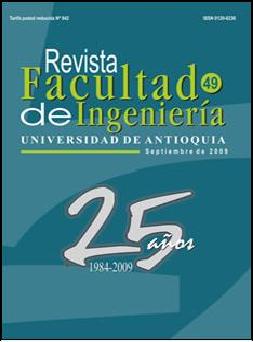Remoción mediante vermicomposteo de los coliformes fecales presentes en lodos biológicos
DOI:
https://doi.org/10.17533/udea.redin.15966Keywords:
Coliformes fecales, lodo, vermicomposteo, remoción de patógenoAbstract
En este trabajo se buscó establecer el efecto de la densidad inicial de lombrices en la remoción de patógenos, mediante vermi composteo de lodo, usando como indicador el número más probable de coliformes fecales (NMPCF). El lodo utilizado se generó en una planta de aireación extendida, se trabajó con4 densidades: alta con 0,2 kg lombrices/kg lodo, media con 0,1 kg lombrices/kg lodo, baja con 0,05 kg lombrices/kg lodo y un blanco sin la adición delombrices al lodo. Al segundo día de experimentación con la densidad mediase logró una mayor remoción, estadísticamente significativa, del NMPCF quela obtenida con la densidad alta. El mismo día, todas las densidades lograronla clasificación de lodo clase B según United States Enviroment ProtectionAgency. Entre el día 13 y el 20 las muestras con densidades alta, baja y medialograron la clasificación clase A, no así el blanco. Al día 20 tanto la densidad media como la alta lograron el 100% de remoción de los coliformes fecales.Downloads
References
K. Nadaffi, M. Zamanzadeh, A. Azimi, A, Omrani, A. Mesdaghinia, E. Mobedi. “Effect of Temperature, Dry Solids and C/N Ratio on Vermicomposting of Waste Activated Sludge”. Pakistan Journal of Biological Sciences. Vol. 7. 2004. pp. 1217-1220.
E. Benitez, R. Nogales, C. Elvira, G. Masciandaro, B. Ceccanti. “Enzyme Activities as Indicators of the Stabilization of Sewage Sludges Composting with Eisenia foetida”. Bioresource Technology. Vol. 67. 1999 pp. 297-303.
P. M. Ndegwa, S. A. Thompson, K. C. Das. “Effects of Stocking Density and Feeding Rate on Vermicomposting of Biosolids”. Bioresource Technology. Vol. 71. 2000. pp.5-12.
J. Domínguez, C. A. Edwards, S Subler. “A Comparison of Vermicomposting and Composting”. BioCycle. Vol. 38. 1997. pp. 57-59.
L. Rodríguez, J. Povinelli. “A Vermicompostagem do Lodo de Lagoas de Tratamento de Efluentes Industriais Consorciada com Composto de Lixo Urbano”. Engenharia Sanitaria e Ambiental. Vol. 9. 2004. pp. 218-224.
AWTT, Vermitech. “Report on Very Large Scale Vermiculture Research”. Queensland, Department of Communication and Information. Local Government and Planning. Queensland, Australia. 1999. pp. 5-19.
J. Haimi. “Growth and Reproduction of the Compost Living Earthworm Eisenia adrei and Eisenia foetida”. Revue d’Ecologie et de Biologie du Sol. Vol. 27. 1990. pp. 415-421.
S. J. Giacomini, E. M. Nunes, A. Santi, S. Ferigolo, S. Juárez, M. Medianeira. “Utilização de Lodo de Esgoto da Estação de Tratamento de Santa Maria na Vermicompostagem”. Actas del XXVI Congreso Brasileiro de Ciencia de Solo. Brasil. 1997.
B. Ceccanti, G. Masciandaro. “Reasearchers Study Vermicomposting of Municipal and Papermill Sludges”. BioCycle. Vol. 40. 1999. pp. 71-72.
J. Domínguez, C. A. Edwards, M. Webster. “Vermicomposting of Sewage Sludge: Effect of Bulking Materials on the Growth and Reproduction of the Earthworm Eisenia Andrei”. Pedobiologia. Vol. 44. 2000. pp. 24-32.
C. D. da Silva, L. M. da Costa, A. T. Matos, P. R. Cecon, D. D. Silva. “Vermicompostagem de Lodo de Esgoto Urbano e Bagaço de Cana-de-Açúcar”. Revista Brasileira de Engenharia agrícola e Ambiental. Vol. 6. 2002. pp. 487-491.
B. Molina, V. Droppelmann, E. Arévalo, H. Moreno. “Tratamiento de Lodos Provenientes de la Planta de Tratamiento de Aguas Residuales del Aeropuerto Arturo Merino Benítez mediante Compostaje y Lombricultura”. En actas del XIV Congreso Chileno de Ingeniería Sanitaria y Ambiental. Santiago. 2001.
B. R. Eastman, P. N. Kane, C. A. Edwards, L. Trytek, B. Gunadi, A. L. Stermer, J. R. Mobley. “The Effectiveness of Vermiculture in Human Pathogen Reduction for USEPA Biosolids Stabilization”. Compost Science and Utilization. Vol. 9. 2001. pp. 38- 49.
WEF (Water Environment Federation). “Standards for the Use and Disposal of Sewage Sludge (40CFR Parts 257, 403 and 503)” Final Rule and Phased-In Submission of Sewage Sludge Permit Application (Revisions to 40 CFR Parts 122, 123 and 501) Final Rule. Excerpted from the Federal Register. Vol. 58. 1993. pp. 9248-9415.
Downloads
Published
How to Cite
Issue
Section
License
Revista Facultad de Ingeniería, Universidad de Antioquia is licensed under the Creative Commons Attribution BY-NC-SA 4.0 license. https://creativecommons.org/licenses/by-nc-sa/4.0/deed.en
You are free to:
Share — copy and redistribute the material in any medium or format
Adapt — remix, transform, and build upon the material
Under the following terms:
Attribution — You must give appropriate credit, provide a link to the license, and indicate if changes were made. You may do so in any reasonable manner, but not in any way that suggests the licensor endorses you or your use.
NonCommercial — You may not use the material for commercial purposes.
ShareAlike — If you remix, transform, or build upon the material, you must distribute your contributions under the same license as the original.
The material published in the journal can be distributed, copied and exhibited by third parties if the respective credits are given to the journal. No commercial benefit can be obtained and derivative works must be under the same license terms as the original work.










 Twitter
Twitter